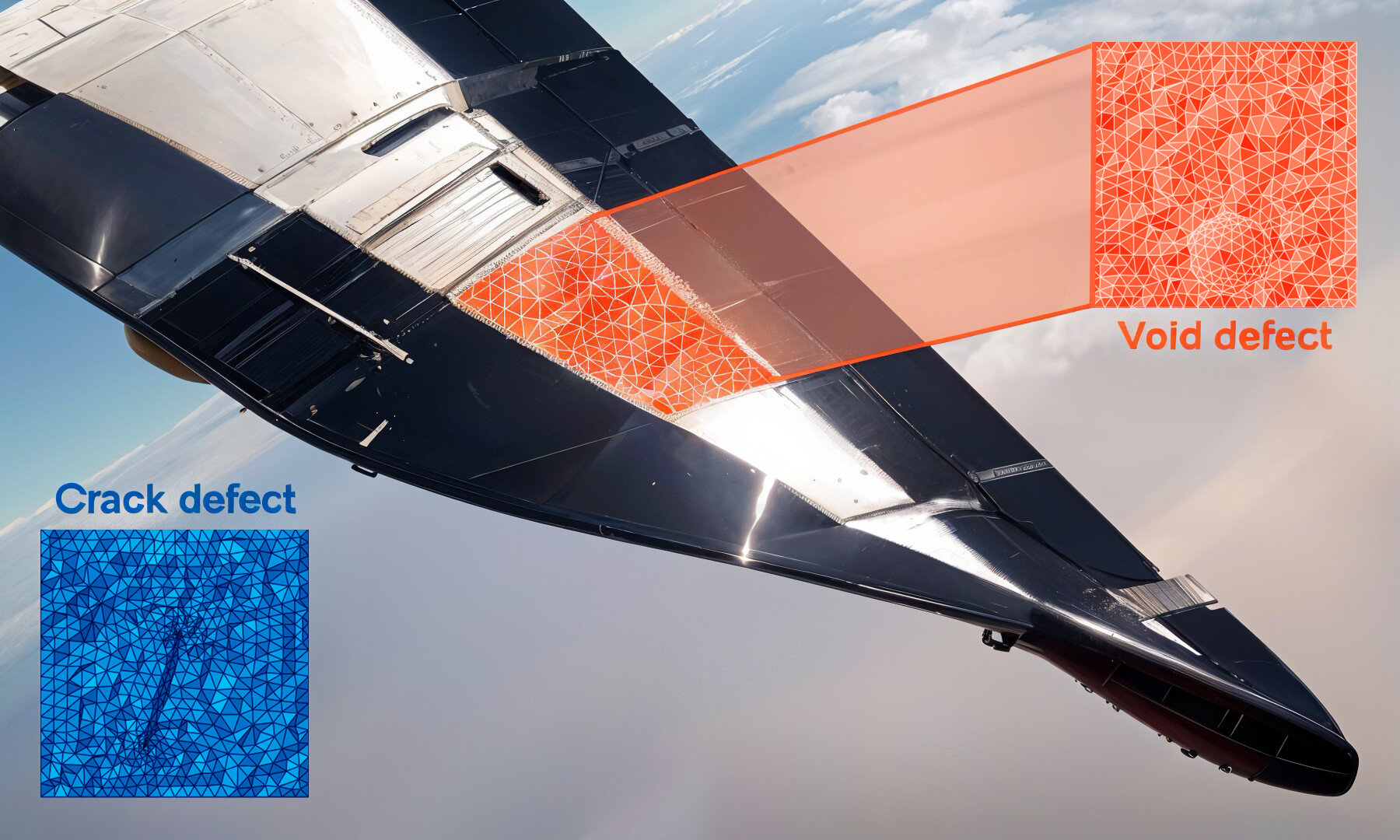Skoltech researchers have created a digital twin of a polymer composite materials with a 2D sensor and efficiently used it for structural integrity testing. The brand new know-how can be utilized to fabricate varied giant constructions, reminiscent of plane wings, wind turbine blades, and bridge spans, that are presently manufactured from polymer composites.
The layer of carbon nanotubes that the crew inserted between the fiber-reinforced layers of the composite is so skinny that including a 2D sensor doesn’t have an effect on the thickness or general design of an plane pores and skin or different half.
Defects in plane elements will be detected primarily based on the adjustments within the electrical conductivity of the layer, and measurements may even be made throughout flight. This method, referred to as electrical impedance tomography, is a extra environment friendly and cheaper various to fiber-optic sensors.
Two papers describing the outcomes of the digital twin checks got here out in Composite Constructions and Worldwide Journal of Engineering Sciences.
Early detection of defects in a polymer composite half, reminiscent of an plane wing or the underside of a yacht, is ensured by embedded fiber optic sensors. A change within the sensor’s sign signifies cracking or delamination—the most typical failures in polymer composites.
Fiber-optic sensors have a number of drawbacks. First, the sign processing tools is dear. Second, these one-dimensional sensors can solely detect defects alongside the fiber path. Third, fiber optic sensors are likely to have an effect on the power of the fabric.
“A polymer composite consists of a number of layers of carbon or glass fibers impregnated with epoxy resin and sintered collectively. Their diameter is 5–10 microns, in comparison with 50–150 microns for optical fibers. To place this in perspective, enhance these dimensions 1,000-fold and you’re going to get a stack of pencils glued collectively, with one thing as giant as a two-liter bottle of soda squeezed inside,” says Sergey Abaimov, the examine’s principal investigator and a number one analysis scientist at Skoltech Petroleum.
“Integrating this sensor with out compromising the power of the fabric and inflicting pressure concentrations is a frightening process. On this instance, a nanotube a number of tens of nanometers thick can be corresponding to a thread that may be neatly hid in a pencil field.”
Beforehand, Abaimov’s crew had proposed a substitute for optical fibers by changing one of many fiber layers within the composite with a layer of electrically conductive carbon nanotubes, which may act as a sensor to observe the integrity of the half.
In an earlier examine, the researchers fabricated and strength-tested a pattern of a modified composite and located that the nanotubes not solely didn’t degrade the fabric’s properties, however truly improved them.
Of their new examine, the researchers examined the digital twin and located {that a} change within the electrical sign in a layer of nanotubes can assist discover defects within the composite. Such a 2D sensor has a a lot wider protection than a 1D optical fiber, however deciphering its sign is a process in itself, which the crew addressed by putting electrodes (within the mannequin) alongside the sensor’s perimeter to be able to measure {the electrical} potential.
With greater than two electrodes, the sensor turns into two-dimensional, eliminating the second disadvantage of fiber optics: no matter its location, a defect at all times falls inside the sensor’s vary. As well as, the sign processing tools for electrical tomography is far inexpensive than that for optical alerts.
A regular-issue electrical resistance multimeter is employed, it is simply that the multichannel mannequin needs to be used to accommodate many electrodes.
“Extracting fracture knowledge from the multichannel electrode sign was the largest problem which we efficiently overcame by coaching machine studying algorithms to detect defects. We used the voltage readings from the electrodes as enter vectors within the machine studying mannequin and immediately predicted the spatial distribution of the defect utilizing a voxel-based illustration of the nanocomposite,” explains Iskander Akmanov, the lead writer of the 2 new papers on the integrity monitoring know-how and a Petroleum Engineering Ph.D. scholar at Skoltech.
The researchers have been profitable of their efforts to make sure that machine studying wouldn’t solely detect fracture defects, but additionally their areas, sizes, and shapes.
The crew plans to check the brand new algorithms on an actual object, reminiscent of part of an plane wing, and implement the know-how within the plane trade.
Extra data:
Iskander S. Akmanov et al, Machine studying for nano-level defect detection in aligned random carbon nanotubes-reinforced electrically conductive nanocomposite, Composite Constructions (2024). DOI: 10.1016/j.compstruct.2024.118651
Iskander S. Akmanov et al, Machine studying for crack detection in an anisotropic electrically conductive nano-engineered composite interleave with real looking geometry, Worldwide Journal of Engineering Science (2024). DOI: 10.1016/j.ijengsci.2024.104171
Offered by
Skolkovo Institute of Science and Know-how
Quotation:
Digital twin confirms nanotubes can detect cracks in plane wing mid-flight (2024, November 13)
retrieved 13 November 2024
from 7Es
This doc is topic to copyright. Other than any truthful dealing for the aim of personal examine or analysis, no
half could also be reproduced with out the written permission. The content material is offered for data functions solely.
